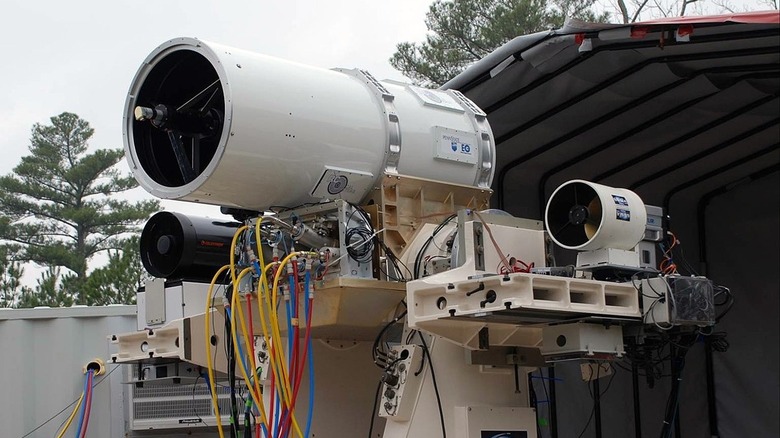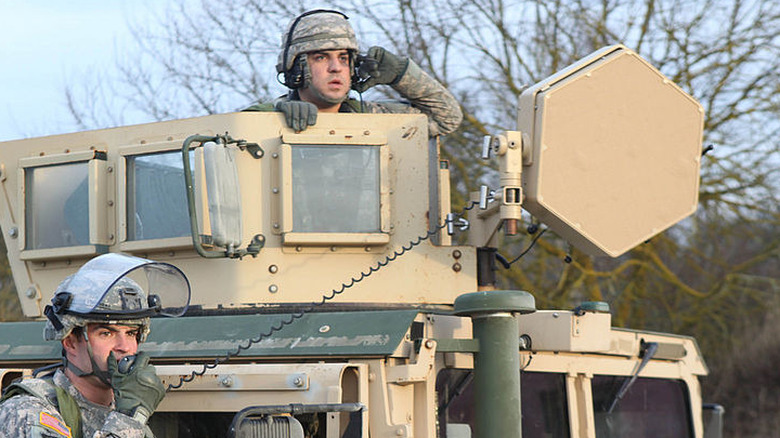What We Know About The Medical Mystery Known As Havana Syndrome
For decades, working in the U.S. Foreign Service has held a glamorous allure. You can travel the world, see new places, learn a new language, and do it all on the government dime. But there is a dark side to working in the Foreign Service — the U.S. has lots of enemies, and you work far from home, outside of the protection of U.S. borders and laws.
Hundreds of Foreign Service personnel have been killed while overseas, and many more have been injured (via the American Foreign Service Association). Usually, these casualties occur in the midst of war, social unrest, or political upheaval, but since 2016, reports of a new kind of "attack" have been popping up. The alleged attacks began in Cuba in late 2016 and are characterized by a highly-localized sonic phenomenon that produced a high-pitched sound, impaired balance, a feeling of pressure, and pain. Worse, there were sometimes lasting effects similar to a concussion. Since then, about 1,000 people have come forward with similar experiences (via NBC News).
What's been going on?
The first case of what would be called Havana Syndrome was reported in Cuba in December 2016 by an undercover CIA operative. Over the next months, more reports came in, all from CIA officers (via The New Yorker). In June 2017, Canadian consular officials began to be affected as well (via The Globe and Mail). American diplomats were again stricken with Havana Syndrome in 2018 in Guangzhou, China. The number afflicted was never disclosed, but some staff members were evacuated to the United States (via The New York Times). Just last summer, two diplomats were evacuated from Hanoi, Vietnam, with symptoms consistent with Havana Syndrome (via NBC News).
These alleged attacks have also happened on American soil. Beginning in 2018, high-level officials in the Department of Homeland Security started suffering from Havana Syndrome. The incidents occurred not just inside of Washington, D.C. but also on the grounds of the White House. None of these cases have been resolved (via CBS News).
What are the symptoms?
The Office of the Director of National Intelligence identified four characteristics of Havana Syndrome, or what it terms "Anomalous Health Incidents" — the rapid onset of strange sounds; a simultaneous sense of vertigo and sometimes ear pain; a strong sense of "locality or directionality"; and a lack of an environmental or medical explanation.
Often, these symptoms are only temporary, but there can be longer-term problems. A 2019 paper in the Journal of the American Medical Association found that there were significant structural differences in the brains of diplomats who had Havana Syndrome but didn't elaborate on the consequences of these differences. Some doctors have called Havana Syndrome the "Immaculate Concussion" due to similarities to long-term symptoms and traumatic brain injuries (via The New Yorker). Many people exposed to this phenomenon report issues with vision, hearing, balance, and speaking (via CBS News).
What's causing this?
No one knows, but one of the prime suspects for a cause of Havana Syndrome is pulsed electromagnetic radiation. The ODNI report states that these types of attacks would be concealable and have an effective range over 100 yards. Although no one seems to know of any weapon capable of causing Havana Syndrome, there are similar weapons deployed around the world by militaries and police forces. They're called directed-energy weapons, and they're a mainstay of non-lethal arsenals.
These weapons work by converting regular electrical energy into radiative energy (typically microwaves). By coupling this with high-energy pulses, military scientists have made devices that can emit pulsed microwave beams with gigawatts of power. The human brain also acts as a kind of receiver for high-powered microwaves, causing some to hear sounds and even voices (via SciTechDaily).
One drawback to this theory is that even though militaries already use pulsed-microwave weapons, they are used primarily to disrupt and damage electrical systems. Yet investigations into Havana Syndrome haven't found any cases of electrical damage.
But wait, there's more
The next most likely candidate for the Havana Syndrome mystery weapon is ultrasound. U.S. police forces use ultrasonic weapons as a means of non-lethal crowd control — they're called long-range acoustical devices, and they can project voices at long distances or emit a loud tone (+160 decibels) that can cause permanent hearing loss, dizziness, and headaches (via Salon). One problem with the ultrasound hypothesis is that ultrasonic waves don't penetrate walls very well, therefore they have to be used at close range (via the Office of the Director of National Intelligence).
Another leading theory is that it's all in their heads, at least for a majority of the cases. A syndrome is a collection of symptoms without a known underlying illness, and to date, no cause of Havana Syndrome has been found. In The Conversation, Dr. Robert Baloh suggests that it's a "mass psychogenic illness" similar to the dancing plagues of the Middle Ages. But this explanation fails to account for the structural changes seen in the brains of some patients (via JAMA).
Where we are today
In January, NBC News reported that the CIA determined that there was not an ongoing global campaign to harm U.S. diplomats. Out of the hundreds of reported cases, the agency believes that most of them can be explained by mundane causes, but it's still stumped by dozens of incidents.
But just last month, CBS' "60 Minutes" examined the issue in-depth, bringing to light many of the cases that have occurred in the U.S. against Homeland Security personnel. Former national security advisor John Bolton only quibbles a little when asked if he thinks it was an attack, saying, "I don't think there's any other hypothesis when you begin to look at the number and the pattern that we've experienced."
As of now, there is no resolution to the ongoing cases of Havana Syndrome. The best-case scenario is an unfortunate series of coincidences with no common cause between them. On the other hand, the worst-case scenario is we have been witnessing the opening salvos of a 21st-century cold war.





